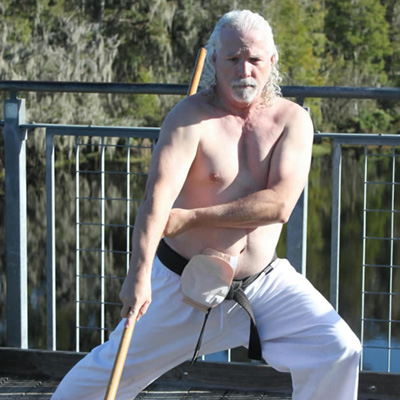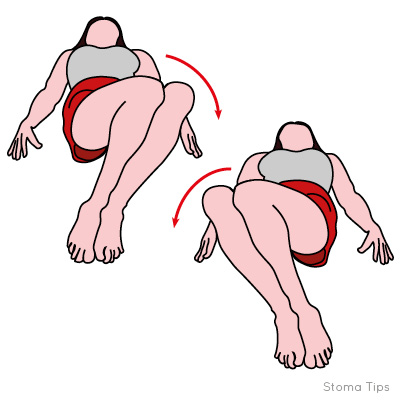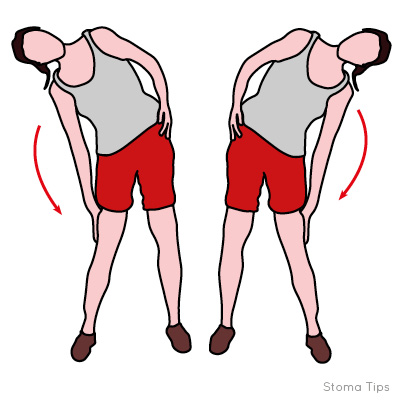During abdominal surgery to create a stoma, an incision is made into the abdominal wall and muscle to allow the bowel to be brought to the surface of the abdomen. This weakens the muscle in that area.
If the surrounding muscle is not sufficiently strengthened and supported, a loop of bowel may protrude though the muscle and form a lump under the skin around the stoma. This is known as a parastomal hernia. Parastomal hernias are a common problem for people with a stoma, causing a degree of discomfort and inconvenience. Although there are some risk factors that make a hernia even more likely, all ostomates are at a high risk if they don’t take the right precautions.
Keeping supported
There are a few strategies to reduce your risk of developing a hernia, or to prevent an existing hernia from getting bigger. This involves avoiding any unnecessary strain and making sure the muscles are supported when they are being used. When coughing or sneezing, try to support abdomen with the arms or a rolled-up towel. Lifting heavy objects should be avoided, but if it’s necessary, make sure to lift with the right posture.
There is a wide range of support garments that hold the muscles in place. It is always worth wearing these when doing anything strenuous, such as exercise, shopping and housework. Stoma care nurses are able to advise, and a detailed guide is available in the Spring 2018 issue of Stoma Tips.
???
If you have to lift something, bend your knees and keep your back straight
Staying strong
The abdominal muscles should not only be supported, they should be strengthened with exercise. Exercising has many other benefits. After surgery, being active helps to speed up recovery, and patients are encouraged to exercise to get back to normal. Keeping to a healthy bodyweight also reduces the risk of a hernia, along with many other serious health conditions.
It can also improve body confidence, and many kinds of exercise are social and offer avenues to meet people. People who exercise tend to sleep better, have stronger bones and experience less stress and depression. Exercising can improve the relief of back pain and help maintain good posture, which may help to prevent hernia formation.

A number of physical activities can help build and maintain strong core muscles
Working out
There are some simple and gentle exercises designed to strengthen the core abdominal muscles and prevent a parastomal hernia from forming. These can be performed straight after surgery. The exercises don’t need to be strenuous, and for 12 weeks after surgery you should not be lifting any heavy weights or doing anything strenuous. If you kept fit before surgery, you may find you can resume your usual exercise regime sooner than the usual 12 weeks, but do speak to your consultant or stoma care nurse first. You don’t need to go to the gym if you don’t want to, as these exercises can be done lying on a bed or a thick mat or sitting in a chair.
Exercises
The exercises in this article have been adapted from the Colostomy Association2
They can be performed daily, on a bed or thick mat at home, so long as you are well
Exercise 1: Pelvic tilt

1. Lie with your knees bent and feet on floor
2. Breathe in and relax your upper body
3. Breathe out and gently arch spine upwards
4. Breathe in at the end of the pelvic tilt
5. Breathe out and gently flatten spine
Perform three times; do not try to get too high; keep hold of pelvic muscle while moving
Exercise 2: Knee roll

1. Lie on your back with your arms to the sides
2. Breathe in and out
3. Roll knees to one side, not touching the floor
4. Breathe in and briefly hold this position
5. Breathe out and bring knees back up
Perform three times for each side; keep shoulder blades on the floor
Exercise 3: Standing side bend

1. Stand with arms down and shoulders relaxed
2. Breathe in and imagine standing taller
3. Breathe out, gently lean to the side without pushing hips out and slide hand down thigh
4. Breathe in and come back to standing
Perform three times for each side; don’t lean forward; imagine standing between two walls
Exercise 4: Calf raises

1. Stand tall, keeping arms down and shoulders relaxed
2. Breathe in and push up on your toes
3. Breathe out, enage your pelvic floor and slowly lower yourself down
Perform five times; try not to lean forward; imagine rising up in a straight line
Exercise 5: Arm raises

1. Sit with buttocks even and feet on the ground
2. Breathe in and sit slightly taller
3. Breathe out and gently raise arm, keeping the elbow soft and shoulder blade down
4. Breathe in and return your arm to your side
Perform three times with each arm; do not lean sideways as you raise your arm; keep sitting tall
Exercise 6: Leg lift

1. Lie on back with natural spine and still pelvis
2. Breathe in, expanding rib cage
3. Breathe out and bring knee up to right angle
4. Breathe in when the knee is at a right angle
5. Breathe out and gently return foot to floor
Wait until 8 weeks after surgery; perform three times for each leg; no pressure on foot on floor
Sustaining hydration
When exercising, keep an eye on your hydration, particularly if you have an ileostomy. Make sure you have drunk enough fluids before you exercise. The colour of your urine is a good indicator of dehydration, and a strong colour suggests you need more fluids. Drinking water alone is not ideal and can encourage even more fluid loss. Rehydration drinks are much better, and milk is good too.
Controlling output
Many ostomates prefer to exercise when their stoma is less active. This is typically linked to meal times, and when you know your stoma’s pattern of activity, you can plan exercise accordingly. Some people like to leave a generous amount of time between eating and exercising.
To reduce the sensation of output swishing about in a pouch, you can use absorbent sachets that you place in the pouch, where they absorb any liquid. To slow liquid output and prevent dehydration, ileostomates may wish to ask a stoma nurse or GP whether they can take loperamide tablets before exercise, with advice on timing and dosage from a stoma nurse.
During periods of increased physical activity, some find it useful to use flange extenders around the edge of the pouch to secure the seal around the stoma and prevent leaks.
???
Once strength has been built back up, you can try more strenuous exercise, like cycling
Moving on
After surgery, walking is an ideal way to build up strength and stamina. You can start gentle and build up length and speed. This could at first be around the house and move up to a brisk walk around the neighbourhood.
You should soon be able to move onto other activities, including fitness programmes and sports. Just make sure to speak to your stoma care nurse about how to do this safely. Please also speak to a personal trainer or instructor when starting any fitness classes or gym workouts to commence gently and safely. You could state you have had abdominal surgery if you don’t wish to inform them of your stoma.
• Yoga and pilates are particularly useful for maintaining a strong core
• Swimming is a good all-round exercise—many highstreet retailers offer high-waisted, patterned or supportive swim wear, and specialist swimwear for ostomates is available, including from Respond, Vanilla Blush and the White Rose Collection
• Running and cycling are good rigorous fitness activities once you have built up your strength, just make sure to wear support garments
• Contact sports can be made safer by wearing stoma shield, a hard case that fits over the stoma with a belt, protecting it from impacts.
Find an activity that you enjoy, whether it is a tough contact sport or a gentle stroll, and reward yourself for doing it!
References
1 Russell S. Physical activity and exercise after stoma surgery: overcoming the barriers. Br J Nurs. 2017; 26(5):S20–6
2 Colostomy Association. Active ostomates: sports and fitness after stoma surgery. www.colostomyuk.org
Reducing the risk
Strengthening the muscles is only one part of the solution, and it is equally important to wear support garments and take care not to strain your abdomen. All together, these strategies will not make getting a hernia impossible, but they will hugely reduce the risk of it happening.
Risk factors for a hernia
• Being overweight
• Abdominal surgery
• Poor nutrition
• Smoking
• Straining the abdomen
 Benjamin Wakefield is the editor of Gastrointestinal Nursing
Benjamin Wakefield is the editor of Gastrointestinal Nursing
The contents of this page are property of MA Healthcare and should not be reused without permission

